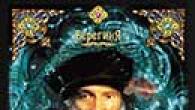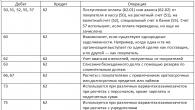The letter Ъ - “hard sign” - is the 28th letter of the Russian alphabet. In modern language, a hard sign does not indicate a sound and serves as a kind of guide for the correct pronunciation of a number of words. However, the hard sign is one of the symbols that formed the basis of the Cyrillic alphabet and, to this day, has gone through a long and difficult path along with the development of the language.
Words with a hard sign: a little history
The hard sign has been known in Cyrillic graphics since ancient times. In the Old Russian language, the letter had a different name - “er” and in some roots it could be pronounced as “o”, and was also written at the end of words ending in a consonant, and after a prefix with a consonant before a root starting with a vowel. This use was practiced until the beginning of the twentieth century. In 1918, during the reform of Russian spelling, the writing of a hard sign at the end of words ending in a consonant was abolished. Today, words with a hard sign in the Russian language are characterized by a total number of more than 140, and the use of this letter is clearly regulated. Let's talk about this in more detail.
Basic groups of words with a hard sign and their spelling norms
Modern Russian language uses the symbol “Ъ” as a separator. The hard sign is used after consonants before iotated vowels e, e, yu, i, mainly at the junction of morphemes.

Solid sign between prefix and root
1. After prefixes ending in a consonant, before a root beginning with a vowel, and in words with native Russian prefixes ( eat, departure, go around, cringe, sarcastic), and in words with borrowed prefixes ( counter-tier, sub-core, trans-European).
2. A separate group consists of borrowed words with a solid sign, starting with combinations ob-, sub-, ad-, ab-, diz-, inter-, con- and others, which were originally prefixes, but in modern Russian are identified as part root: object, subject, adjutant, abjuration, disjunction, injection, conjuncture.
Hard sign between parts of compound words
1) before the second root after parts two-, three-, four- ( two-tier, three-anchor, four-capacity);
2) words with a separating solid sign are highlighted separately, such as courier And pan-European;
3) if we are talking about the spelling of complex abbreviated words with a similar structure, then a hard sign is not used in them: specialist, owner, military officer, state language and others.

Hard sign in proper names and their derivatives
There are a number of nouns and derivatives from them (names of people and geographical names), where the hard sign is also used: city Kizilyurt, village Toryal, lake Jyväsjärvi, artist Guo Hengyu.
Thus, words with a hard sign in the modern Russian language are a separate group with their own patterns in spelling. Unlike a soft sign, which can be used several times in the same word, a hard sign can only be used once in one word. The above cases of using a hard sign are clear rules that must always be followed. In situations not discussed in this article, under similar conditions, a soft separating sign is used.
The famous Soviet-era linguist Lev Uspensky calls it the most expensive letter in the world. In his work on the origin of words, one can see how he relates to it. In his words, “she absolutely does nothing, helps nothing, expresses nothing.” A pertinent question arises - how did the letter Ъ appear in the Russian language, and what role did the creators assign to it?
The history of the appearance of the letter Ъ
The authorship of the first Russian alphabet is attributed to Cyril and Mythodius. The so-called Cyrillic alphabet, which was based on the Greek language, appeared in 863 after the birth of Christ. In their alphabet, the hard sign was number 29 and sounded like ER. (before the reform of 1917-1918 - 27th in a row). The letter Ъ was a short semi-vowel sound without pronunciation. It was placed at the end of a word after a hard consonant.
What then is the meaning of this letter? There are two tractable versions of this explanation.
The first option concerned the Old Church Slavonic letter itself. Since the familiar spaces at that time simply did not exist, it was she who helped to correctly divide the line into words. As an example: “to God’s chosen king.”
The second explanation is associated with the Church Slavonic pronunciation of words. It was ER that did not muffle the voiced consonant when reading the word, as we see in modern Russian.
We pronounce the words flu and mushroom, which have different meanings, the same way – (flu). There was no such sound phonetics in the Old Church Slavonic language. All words were both written and pronounced. For example: slave, friend, bread. This was explained by the fact that the division of syllables in the Old Church Slavonic language was subject to one law, which sounded like this:
“In the Old Church Slavonic language, the ending of a word cannot have consonants. Otherwise the syllable will be closed. What cannot happen according to this law.”
In view of the above, we decided to assign ERb (Ъ) at the end of words where there are consonants. So it turns out: Deli, Tavern, Pawnshop or Address.
In addition to the above two reasons, there is also a third. It turns out that the letter Ъ was used to denote the masculine gender. For example, in nouns: Alexander, wizard, forehead. They also inserted it into verbs, for example: put, sat, (past tense masculine).
Over time, the letter Ъ performed the function of a word separator less and less often. But the “useless” Kommersant at the end of the words still held its position. According to the aforementioned linguist L.V. Uspensky. this small “squiggle” could take up up to 4% of the entire text. And these are millions and millions of pages every year.
18th century reforms
Anyone who believes that the Bolsheviks fired a control shot at the “head” of the ill-fated letter Kommersant and thereby cleansed the Russian language of church prejudices is a little mistaken. The Bolsheviks simply “finished off” her in 1917. It all started much earlier!
Peter himself thought about language reform, especially about Russian writing. An experimenter in life, Peter had long dreamed of breathing new life into the “decrepit” Old Church Slavonic language. Unfortunately, his plans only remained plans. But the fact that he got this issue off the ground is his merit.
The reforms that Peter began from 1708 to 1710 primarily affected the church script. The filigree “squiggles” of church letters were replaced by common civilian ones. Letters such as “Omega”, “Psi” or “Yusy” have disappeared into oblivion. The familiar letters E and Z appeared.
The Russian Academy of Sciences began to think about the rationality of using certain letters. So the idea of excluding “Izhitsy” from the alphabet arose among academicians already in 1735. And in one of the printing publications of the same academy, a few years later an article was published without the notorious letter B at the end.
Control shot for the letter Ъ
In 1917, there were two shots - one on the cruiser Aurora, the other at the Academy of Sciences. Some people believe that the reform of Russian writing is the merit of the Bolsheviks exclusively. But historical documents confirm that in this matter, tsarist Russia also moved forward.
In the first years of the 20th century, Moscow and Kazan linguists were already talking about the reform of the Russian language. 1904 was the first step in this direction. A special commission was created at the Academy of Sciences, the purpose of which was to simplify the Russian language. One of the questions at the commission was the notorious letter B. Then the Russian alphabet lost “Fita” and “Yat”. New spelling rules were introduced in 1912, but, unfortunately, they were never censored then.
Thunder struck on December 23, 1917 (01/05/18). On this day, People's Commissar of Education Lunacharsky A.V. signed a decree on the transition to a new spelling. The letter Kommersant, as a symbol of resistance to the Bolsheviks, breathed its last.
In order to speed up the funeral of everything that was associated with the “tsarist regime,” on November 4, 1918, the Bolsheviks issued a decree on the removal of the matrix and letters of the letter Kommersant from printing houses. As a result of this, a spelling miscarriage of the Bolsheviks appeared - the apostrophe. The function of the separator was now played by a comma (lifting, moving).
One era has ended and another has begun. Who would have thought that the small letter B would become so big and important in the confrontation between two worlds, white and red, old and new, before and after the shot!
But the letter Ъ remained. It remains simply as the 28th letter of the alphabet. In modern Russian it plays a different role. But that's a completely different story.
DividingKommersantwritten after consonants before lettersI, Yu, Yo, E,conveying combinations [j] with vowels, in the following cases.
1. After prefixes ending in a consonant .
For example:
a) in words with Russian prefixes: non-nuclear, reveal, enraged, become enraged, worn out, interlingual, get fed up, go around, departure, lift, pre-anniversary, present, disperse, detachable, eat, shrink, sarcastic, supernatural, super-capacious, super-bright.
Letter ъ traditionally it is also written in the word flaw, Although from- is not a prefix in it.
b) in words with prefixes of foreign origin : counter-tier, post-nuclear, post-anniversary, subunit, subcore, superyacht, trans-European .
Words of foreign origin with initial parts are also written ab-, ad-, dis-, in-, inter-, con-, ob-, sub- , which in the source language are prefixes, but in the Russian language they are usually not distinguished as prefixes. These include: abjuration, adjective, adjectivation, adjunct, adjustage, adjutant, disjunction, injection, injected, interjection, coadjutor, conjecture, conjugates, conjugation, conjunctiva, conjunctiva, conjunctivitis, conjuncture, conjunction, object, objective, subject, subjective .
2. In complex words:
a) after the initial parts two-, three-, four- , For example: double-anchor, double-capacity, triple-core, quadruple-tier ;
b) in words pan-European, courier .
After the initial parts of compound words, a separator ъ traditionally it is not written, for example: military lawyer, state language, children, party cell, food fair, special education, household unit, foreign language, Inyurkollegiya, Ministry of Justice.
3. The letter ъ is also written when transmitting foreign proper names and words derived from them (after letters containing paired hard consonants), for example: Kizilyurt(city in Dagestan), Toryal(village in the Republic of Mari El), Guo Hengyu(Chinese personal name), Hengyang(city in China), Tazabagyab culture(archaeological), Jyväsjärvi(lake in Finland), Manyoshu(anthology of ancient Japanese poetry).
In this case, the separating ъ also possible before the letter And , For example: Junichiro(Japanese name).
Note!
1) The letter ъ is not written before letters a, o, y, e, and, s.
For example: interatomic, counterstrike, transoceanic, three-story.
2) The letter ъ is not written in the middle of a word (not after a prefix!), for example: dress, clerk Exception – courier.
3) The letter ъ is not written at the junction of parts of a compound word.
For example: detyasli (nurseries), Inyaz (Institute of Foreign Languages).
4 ) The letter ъ is not written in a noun clerk(there is no prefix in this word under- !). A separator is written in the middle of the word b , since the prefix stands out here By- and the root dyak (-dyach-).
5) In the middle of a word (at the root) rearguard is written separating ь , but not ъ , since prefixes ar- not in Russian.
6) In a word flaw (Turk.) written ъ by analogy with the verb take away.
Dividing b written after consonants before letters I, Yu, E, E, and, conveying combinations [j] with vowels.
For example:
- ya : devil, yudyachiy, monkey, billiards, family, drunk, ears of corn, draw, shepherd's, Lukyan;
-yu : loach, interview, pour, family, drink, trot, fifty, sew, fut(interjection);
- yo : nightingale, gun, drinking, crow, serious, life, whose, sewing;
-e : premiere, play, courier, entertainer, jam, calm, Vietnam, Fourier;
-y : passerine, nightingales, pancakes, bearish, vary, articles, whose, Vigny.
1) The separating b is written in the middle of the word (not after the prefix!) after a consonant before letters e, e, yu, i, if after a consonant before a vowel it sounds [j]; for example: vVyot [v’jot], loach [v’jun], clerk [d’jak]).
2) The separative b is written in some borrowed words (as a sound signal [j]) after a consonant before a letter O.
For example: bouillon[bul'jon], sir[sin'jor], minion[min'jon].
No matter how they try to convince students that the knowledge they acquired during their school years will be needed in the future, unfortunately, this is not the case. However, some things taught in school will actually be useful in adult life. For example, the ability to write correctly. To master it, you need to know the basic grammatical laws of the Russian language. Among them are the rules governing the use of separating signs ъ and ь.
Hard sign: history and its role in the word
The twenty-eighth letter of the Russian alphabet, despite the fact that it does not represent sounds, performs an important function in words. Therefore, before consideringrules governing the use of ъ and ь signs are worthlearn a little about its history and role in the word.
The hard sign existed in Slavic languages almost from the very moment of their formation. It started out as a short vowel sound until it evolved into an unpronounceable letter used to divide words into syllables and also replace spaces.
At the end of the 19th century. it was noted that the frequent use of ъ in texts (4% of the total volume) is inappropriate, especially in telegraphy, cursive writing and typography. In this regard, attempts have been made more than once to limit the use of a hard sign.
After the revolution of 1917, this letter was completely abolished for almost ten years. In those years, an apostrophe was used as a separator in words.However, in 1928 it was excluded from the Russian language (but remained in Ukrainian and Belarusian), and its dividing function was taken over by a solid sign, which it performs to this day.
In what cases is ъ put in words?
As for the use of a solid sign, there are several rules for placing it before e, yu, ё, i:
- After prefixes that end with a consonant: connector, pre-anniversary.
- In terms that came from other languages, with the prefixes ab-, ad-, diz-, in-, inter-, con-, ob- and sub-: adjuvant, disjunction.
- After counter-, pan-, super, trans- and field-: pan-Europeanism, superyacht.
- In compound words starting with two-, three-, four-: two-core, three-tier, quadrilingual.
There are several exceptions, when ъ does not stand at the junction of a prefix and a root, but inside the word itself. These nouns include: courier and flaw.
When they don't put it
In addition to the rules governing the use of ъ and ь signs, it is worth remembering cases when they do not need to be used:
- A hard sign is not used in words with a prefix ending in a consonant when it is followed by the vowels a, o, i, u, e, s: cloudless, curbed.
- This sign is not used in complex abbreviated terms: inyaz, glavyuvelirtorg.
- It is also not used in lexemes written with a hyphen: half a diocese, half an apple.
When considering the rules governing the use of ъ and ь signs that perform a separating function in a word, it is worth remembering that the lexemes “interior” and “clerk” are written using a soft sign. This spelling is no exception, since in the word “interior” inter is not a prefix, but part of the root. And in “deacon” the prefix is not sub-, but po-, but -deacon is the root.
What functions does a soft sign perform?
As for ь, in ancient times it meant a short vowel [and], but gradually, like ъ, it lost its sound.

At the same time, he retained the ability [and] to impart softness to the preceding consonant sound.
Unlike the hard word, it can perform 3 functions.
- Dividing.
- Informs about the softness of the preceding sound.
- Used to indicate certain grammatical forms.
Rules for using a soft sign
Studying the laws of the Russian languageregulating the use of ъ and ь signs, it is worth learning a few rules:
- A soft sign that performs a dividing function is never placed after a prefix (this is the destiny of a hard sign). Parts of words in which the dividing ь is written are the root, suffix and ending to e, ё, yu, i: monkey, interior. This rule applies to both Russian vocabulary and borrowed terms from other languages.
- The separating word ь is placed in some words before the letter combination it: champignon, medallion, broth and million.
In the case when ь informs about the softness of the preceding sound, and does not perform a dividing function, its production is determined by the following rules:
- In the middle of a word ь indicates the softness of the letter l if it precedes another consonant other than l: finger, prayer. Also, the soft sign does not “wedge” into letter combinations: nch, nsch, nn, rshch, chk, chn, rch, schn ( drummer, candle).
- In the middle of a word, this sign is placed between the soft and hard consonants: please, very much.
- In the middle of a word, ь can stand between two soft consonants. Provided that when the form of the word changes, the first remains soft, and the second becomes hard: request - in a request, letter - in a letter.
- In some cases, this symbol is located at the end of a word after consonants. At the same time, it helps to establish the meaning of the token: linen(plant) - laziness(quality of character), con(place for bets in the game) - horse(animal).
As a marker for individual grammatical forms, this sign is used in the following cases:
- In adjectives arising from the names of months (except January): February, September.
- At the end of numerals from 5 to 30, as well as in their middle, if they denote tens from 50 to 80 and hundreds from 500 to 900: six, seventy, eight hundred.
- In the imperative mood of verbs (except lie down - lie down): take it out, take it out, throw it in, throw it in.
- In the infinitive (initial form of the verb): maintain, raise.
- In all cases of the word “eight” and in the instrumental case it is plural. numbers of individual numerals and nouns: six, lashes.
The use of ь and ъ signs after hissing w, h, shch, sh
Following these soft sign letters is possible under the following conditions:
- At the end of most adverbs and particles, except: I can't bear to get married and in pretext between.
- In the infinitive: preserve, bake.
- In the imperative mood of verbs: anoint, comfort.
- In the second person endings of singular verbs of the future and present tenses: sell it, destroy it.
- At the end of the nominative case of nouns. gender, in III declension: daughter, power. For comparison in m. gender - cry, broadsword.

In some cases, ь is not used after these letters:
- In nouns of the 2nd declension: executioner, dummy.
- In short forms of adjectives: fresh, burning.
- In the genitive case of plural nouns: puddles, clouds
A hard sign after zh, sh, ch, sch at the end of a word or root is not placed, since its “place” is always after the prefix before e, e, yu, i.
Using ь and ъ signs: exercises
Having familiarized yourself with all the cases of setting soft and hard signs, you should move on to the exercises. To avoid confusion, we have collected together most of the above rules governing the use of ь and ъ signs. The table below will serve as a hint for completing the tasks.

In this exercise you need to choose which letter should be placed in the words.

This task concerns the use of a soft sign following sibilant letters. You should open the brackets in it and put a soft sign where necessary.

In the last exercise you need to write down the proposed words in 2 columns. In the first - those that are used with ь, in the second - those that are without it.

Since both hard and soft signs are “silent” letters, they play an important role in the Russian language. You can make many mistakes in your writing if you do not know the laws of grammar governing the use of ъ and ь signs. You will have to learn more than one rule so as not to confuse which sign should be used in a particular situation. However, it is worth it, especially in the case of a soft sign, since often only its presence helps determine the lexical meaning of the word.
Dividing ъ written after consonants before letters I, yu, yo, e , conveying combinations [ j] with vowels, in the following cases.
1. After prefixes ending in a consonant. Examples:
A) in words with Russian prefixes: non-nuclear, reveal, enraged, become enraged, worn out, interlingual, get fed up, go around, departure, lift, pre-anniversary, present, disperse, detachable, eat, shrink, sarcastic, supernatural, super-capacious, super-bright ;
b) in words with prefixes of foreign origin: counter-tier, post-nuclear, post-anniversary, subunit, subcore, superyacht, trans-European .
Words of foreign origin with initial parts are also written ab, hell, diz, in, inter, con, ob, sub, which are prefixes in the source language, but are usually not distinguished as prefixes in the Russian language. These include: abjuration, adjective, adjectivation, adjunct, adjustage, adjutant, disjunction, injection, injected, interjection, coadjutor, conjecture, conjugates, conjugation, conjunctiva, conjunctiva, conjunctivitis, conjuncture, conjunction, object, objective, subject, subjective.
2. In compound words:
A) after the initial parts two, three, four, eg: two-anchor, two-capacity, three-core, four-tier;
b) in words pan-European, courier.
3. Letter ъ It is also written when conveying foreign proper names and words derived from them (after letters that contain paired hard consonants), for example: Kizilyurt(city in Dagestan), Toryal(village in the Republic of Mari El), Guo Hengyu(Chinese personal name), Hengyang(city in China), Tazabagyab culture(archaeological), Jyväsjärvi(lake in Finland), Manyoshu(anthology of ancient Japanese poetry).
In all cases, except those indicated above, after consonants before letters I, yu, yo, e , And , conveying combinations [ j] with vowels, a separating one is written b .
Examples: ya : devil, yudyachiy, monkey, billiards, family, drunk, ears of corn, draw, shepherd's, Lukyan;yu : loach, interview, pour, family, drink, trot, fifty, sew, fut(interjection); yo : nightingale, gun, drinking, crow, serious, life, whose, sewing;ye : premiere, play, courier, entertainer, jam, calm, Vietnam, Fourier;yi : passerine, nightingales, pancakes, bearish, vary, articles, whose, Vigny.






